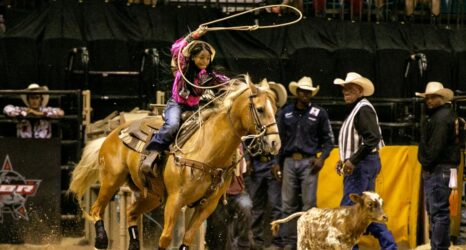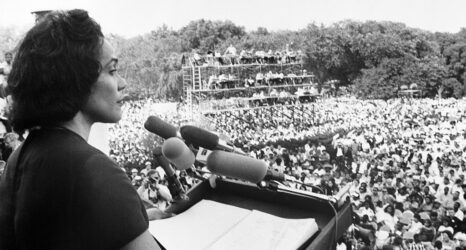As Oscar weekend approaches, Viola Davis and Octavia Spencer are the favorites, respectively, to win this year’s Best Actress and Best Supporting Actress awards. Having two Black women poised to sweep the actress Oscars might seem like progress for Hollywood — but here’s the irony: The parts they are nominated for, from the box-office hit The Help, are that of maids. If either receives the trophy, it will continue a legacy of Black women winning the award for portraying “the help” that dates all the way back to Hattie McDaniel, the first Black person to win an Oscar with her 1939 Best Supporting Actress award for “Mammy” in Gone With the Wind.
What exactly does this say about Hollywood, which recently came under scrutiny because its Academy voters are overwhelmingly white men? It might suggest that, within Hollywood cinema, Black people are ill-represented except as stock characters. In the past, such characters included faithful “Mammys” and “Toms,” buffoon-like “Sambos” and “Coons,” sassy and loud “Sapphires,” sexualized “Jezebels” and “tragic mulattos” who wish they could be white. Recently these characters have evolved into faithful “Black girlfriends” or “best buddies,” loud-mouthed “hoodrats” and criminal “thugs,” and hypersexual Black women. In addition, a cross between Mammy and Sapphire has given birth to the hypermasculine Matriarch, as represented by the cross-dressing antics of Eddie Murphy, Martin Lawrence and Tyler Perry–or even, arguably, in the Oscar-winning performance of Mo’nique in the critically acclaimed Precious.
The problem with these cinematic stereotypes is not that they can’t be entertaining or even well-acted–Davis and Spencer are phenomenal actors–but that they often reduce the humanity of an entire race of people in the eye of the viewing public. Since the U.S. is still racially segregated in our living and educational environments, many non-Blacks only encounter Black women and men on screen. These stereotypes can become their primary impressions of Black Americans.
So what happens to Black women who refuse to be typecast? Light-skinned Black women have been told to deny their race: The multi-talented Lena Horne was once encouraged to “pass” as an “exotic” Latin American woman. When she refused to identify as anything other than African American–and refused maid roles–her film career was cut short. Horne spent most of her career in music and on the stage, but her cinematic legacy is preserved in “soundies” (musical numbers that could be cut from the film when it was shown in Southern states) and in all-Black 1940s film musicals such as Cabin in the Sky and Stormy Weather.
Likewise, the lesser-known actress Fredi Washington received several offers by 1930s Hollywood studio heads to turn her into a bonafide superstar who would outshine Greta Garbo and Joan Crawford–provided that she pass for white. Like Horne, Washington refused, and as a result was relegated to the margins. Studios felt she wasn’t “Black enough” for the usual maid roles offered to Black women. When performing in a rare non-maid role in the film Emperor Jones (1933), she would be forced to wear dark makeup to prevent audiences from viewing her as a white woman, because a romantic entanglement with the Black leading man (Paul Robeson) would have violated Hollywood’s anti-miscegenation code. Washington is best known for a “tragic mulatta” role as Peola in the 1934 film, Imitation of Life, based on Fannie Hurst’s tear-jerker novel and starring Claudette Colbert and Louise Beavers. Peola passes for white and rejects her mammy-like mother (Beavers). Unfortunately, her famous portrayal would be erased from cultural memory with Douglas Sirk’s 1959 remake, in which a white woman, Susan Kohner, plays Washington’s character.
Limited in her roles, Washington instead took up the mantle of theatrical activism and racial uplift. In 1937, she helped to found the Negro Actors Guild, an advocacy group for Black actors onstage and onscreen that fought for better scripts and working opportunities.
Had the Negro Actors Guild not existed, one of AFI’s top 10 movies of all time, Gone with the Wind, would be a much more blatantly racist film than the one we know today (and may not have become such a classic). With the help of the Guild, Hattie McDaniel successfully lobbied for studio heads to erase the N-word from the script. She also refused to do a scene that expected “Mammy” to shine the shoes of her master while on her knees. Likewise, Butterfly McQueen, who played Prissy, wouldn’t do a scene in which her character ate watermelon. McQueen also refused to be slapped onscreen by actress Vivien Leigh–that’s why the famous slap after Prissy says she “knows nutthin’ bout birthin’ no babies” occurs offscreen.
Even as Black women McDaniel and Queen worked with the Guild to agitate behind the scenes, their willingness to take stereotypical roles subjected them to scathing critiques by leading Black voices such as the NAACP. Washington, who would later serve as a major critic and columnist for the radical Harlem newspaper, The People’s Voice, was not quite as condemnatory toward McDaniel, but did challenge the actress to stop defending her right to play the “mammy” roles. Washington also called on Hollywood to offer McDaniel better roles and urged Black audiences to support Black political theater while boycotting Hollywood movies featuring toms, coons and mammies.
Today history repeats itself as Viola Davis, like McDaniel, finds herself having to defend her choice to portray a maid. Davis has argued that “humanity is messy” and that Black artists “cannot live in a revisionist place.” I agree with her that there must be room for complex performances that move beyond reductive debates of “positive” vs “negative” images of African Americans. But I take issue with her position that the “quiet dignity” of her character Aibileen Clark in The Help is somehow more complex than what either McDaniel or McQueen did. Aibileen, the “noble servant,” is a stock character that placates contemporary white guilt, no less stereotypical than McDaniel and Queen’s comedic turns as slave servants in Gone With the Wind, which reassured 1930s whites of their superior racial status.
Rather than put the onus on actors such as Davis to defend their choice to play stock roles and to add “complexity” with their acting, we would do better to take Washington’s lead and demand answers of Hollywood filmmakers and movie audiences. Why do certain Black characters resonate for certain communities, why do they keep surfacing decade after decade and why don’t we have more diverse representations of Black women in cinema? Davis’s fellow Oscar nominees this year portrayed a head of state (Meryl Streep), a cross-dressing butler (Glenn Close), a fragile film icon (Michelle Williams) and a vigilante computer hacker (Rooney Mara). If we have trouble imagining Black women in similar roles, therein lies the problem.
Regardless of the results this Sunday, the choices make clear that Black women’s roles have evolved little over 73 years of Hollywood history. Fortunately, independent cinema continues to subvert Hollywood’s limitations, just as Black theater did in Washington’s time. This year, we’ve seen masterful works from up-and-coming Black female filmmakers like Ava Duvernay and Dee Rees. And just last year we celebrated the 20th anniversary of Julie Dash’s still groundbreaking film Daughters of the Dust. While Hollywood remains stuck in the past, Black audiences may need to look elsewhere to recognize ourselves on film.
Read More:





